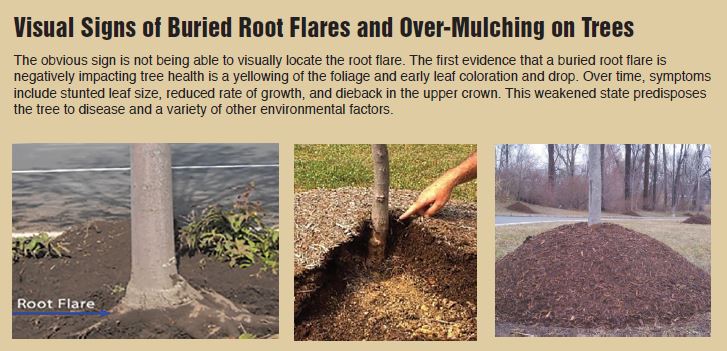By Chuck Whealton, Region Manager
Mulching consists of using organic products as a covering to conserve moisture, reduce soil temperatures, and control weed growth around desired plants. This practice predates written gardening records, as far back as the 17th century. To this day, farmers and homeowners mulch using organics such as leaves, manure, grass clippings, and the hardwood that is universally referred to as mulch. Hardwood mulch as a product, and mulching as a horticultural practice, have greatly evolved over the last fifty years, and not necessarily to the benefit of plants. In fact, the preoccupation with the aesthetic value of mulching has led to an epidemic of over-mulching from a horticultural perspective.
The History
In the 1960s, hardwood (also called bark) mulch grew in popularity throughout the Mid-Atlantic and other areas where hardwood forests were prevalent. Fueled by growth in the housing market and furniture business, the lumber industry was booming. Every lumber mill had a mountain of decomposing bark—a waste product generated in the de-barking of logs for lumber—that they needed to dispose of. By grinding it up a little finer, hardwood bark fit the description of what mulch should be: it was organic, retained moisture, controlled weed growth, partially decomposed, was dark in color and attractive in the landscape. The measure of mulch quality was determined by three main factors: finer was better than coarse, darker was better than light (meaning it had aged longer), and a higher bark content (vs. wood content) meant that the color would fade more slowly. For the next twenty years, well-aged quality mulch was inexpensive and readily available.
By the early 1990s, the furniture industry had moved abroad and the lumber industry in the U.S. was in decline. At the same time, municipalities banned organic green waste in traditional landfills (tree trunks/branches/leaves, shrub trimmings, grass clippings, etc.) due to disposal costs. It had to go somewhere, and so it became a convenient and inexpensive mulch additive. At first it was limited to twenty percent or less by volume, but over time, with improved composting practices, the percent of green waste and wood content increased. By this time, the rich dark appearance of mulch had become synonymous in customers’ minds with well-maintained landscapes, with a “more is better” (or at least better looking) mentality.
Fast forward to the present day, and the lumber industry has all but disappeared. Quality mulch is now a manufactured mix of green waste, ground up stumps and land clearing debris, aged for only a few months and dyed to maintain aesthetic expectations. Lesser quality manufacturers will inject a stream of processed wood, including pallets and construction debris, into their mulch, bringing with it nails, glass, and other foreign material. A higher wood content also means that the mulch takes longer and requires more nutrients to completely decompose. The result is a mulch product far different from its original intent.
The Resulting Problem
While the quality of mulch has drastically changed, its popularity in the marketplace has skyrocketed. The perceived value and purpose of mulching today is largely for aesthetics. There has been a complete shift from bark to largely composted green waste and processed wood mulch, which has a slower rate of decomposition. In addition, commercial contracts routinely call for one or more annual applications of two inches or more of fresh mulch, without regard to the amount of mulch already present. This has resulted in an epidemic of over-mulched landscapes that pose a serious health risk to plants.

The Solution
The only course of action is to remove the current excess mulch and limit the total amount of new mulch and existing mulch to no more than four inches.
- De-mulching should be performed for all trees that have a buried root flare (trees in beds are not exempt from this process)
- Original planting soil rings should be removed two to three years after the initial planting
- De-mulching is likely to be needed as a function of routine maintenance every five to seven years on average when annual mulching is a customer expectation and requirement. Given that today’s mulch takes significantly longer to decompose, a buildup of mulch will occur sooner and must be removed even more frequently in the future.
If addressed in time, declining trees will recover. Based on the severity of decline, trees may need monitoring and supplemental care.
When applying new hardwood mulch, Ruppert uses only mulch manufactured from virgin material, meaning its original use is as mulch, not processed wood or construction debris that likely contains nails and other contaminants. Our suppliers are certified by The Mulch & Soil Council (mulchandsoilcouncil.org). For more information on our mulching practices, contact your area manager.
